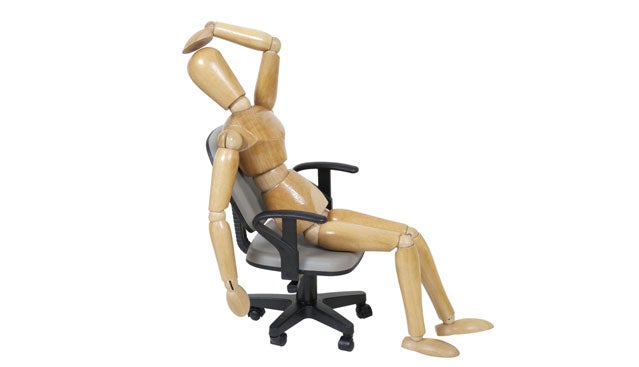Despite the popularity of balls-as-chairs in the workplace, the answer to this question is a cautious “maybe.”
If you work at, let's say, an active lifestyle magazine in Santa Fe, New Mexico, you’re likely accustomed to colleagues perched gingerly atop oversize bouncy balls, like prospective circus performers. Not without reason. Studies have shown that sitting on an exercise ball, as opposed to a regular desk chair, helps to burn an additional 30 . But is it good for your back?
In the gym, exercise balls can provide great stability training, challenging your muscles to keep you balanced as you run through the standard sets of crunches and shoulder presses. As , co-director of Mayo Cinic's sports medicine center points out, “Even if you’re strong, you may not be very stable.” It's important for athletes to train stabilizer muscles to prevent joint injury as they tackle heavier weights or longer runs.
Getting a good fit for your exercise ball is important. As with any sitting device, you should use the “90-90” rule: make sure you're creating ninety-degree angles at your knees and hips, so that your hips are even with your knees, your back and legs are perpendicular to the ground, and your feet are resting squarely on the floor. (If the ball is too high or too low, you’ll end up leaning forward or backward, putting unnecessary stress on the spine.) Since most of us spend much of every day sitting at our desks, Laskowski recommends an ergonomic evaluation, in which a physical therapist comes into your office and fits your workspace to your body. (Some larger companies offer this sort of service in-house.)
Especially when you’re recovering from a lower back injury, working your stabilizers is important. That said, you don’t want to overdo it. As always, Laskowski says, “If it’s causing you pain, making you stabilize too much, then you should ease off.”
And sitting on a ball all day might well be too much for most people. A 2009 study examining the effects of sitting on an exercise ball as opposed to a chair concluded cautiously that “.” A separate 2009 study found that “both seating types [chair and ball] were found to .”
The trouble is, the ball only works if you sit up straight—which most people don't. , an associate professor of spine surgery at the University of California, Los Angeles, specializing in high performance athletes, says that balls are definitely not right for everyone. The benefit of a good old chair, he says, is that it supports your lumbar spine, lowering the pressure on your disks and your risk for disk degeneration: “Maybe initially it’s better to sit on a ball, but as you tire, you can get into trouble. The danger is the typical hunching or arching that happens as the day wears on. It only works if you maintain perfect posture.” As an example, if you get tired or distracted and start leaning to one side, you risk straining the joints on the side of the spine, leading to muscle fatigue, lactic acid buildup, and pain. “Anything beyond five degrees for an extended period of time means you’re putting too much pressure on the spine,” Shamie says.
Unfortunately, no matter how strong you are, your muscles relax as you sit for long periods of time, transmitting more pressure to your disks and joints. In order to maintain your posture, Shamie recommends getting up and walking around every 40 minutes or so to take the pressure off your back and give your stabilizing muscles a chance to reset. He also emphasizes the importance of a full seven or eight hours of sleep to give your back the best opportunity to recover.
Another option, besides an exercise ball, is to avoid the risky business of sitting altogether. A new study out last month indicated that sitting for more than three hours each day, regardless of fitness and exercise level, can literally take several years off your life. The pressure on your spine is far greater when you’re seated than when you’re standing, so consider trying a vaulted, or standing, desk. (Some back injuries are aggravated by standing, so, as always, consult with your doctor if you're dealing with injury.)
The Bottom Line
Stability training is important, but not at the expense of your back. If you do want to try out an exercise ball, be hyper-vigilant about your posture. Or skip the balancing act and try some throughout the day instead.


